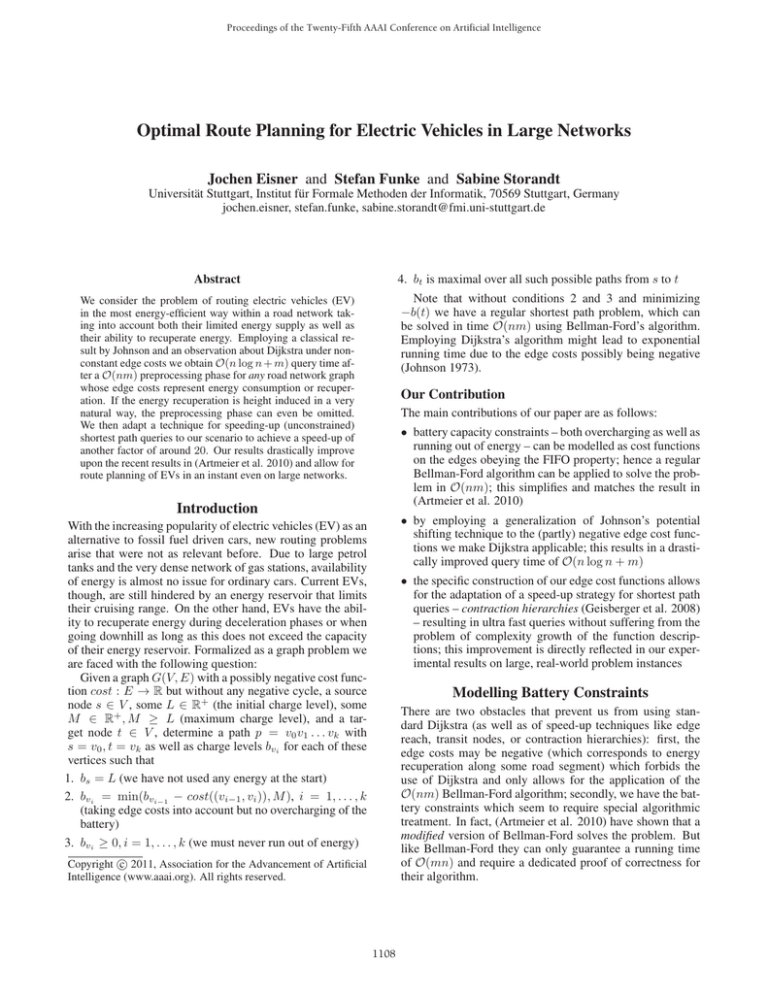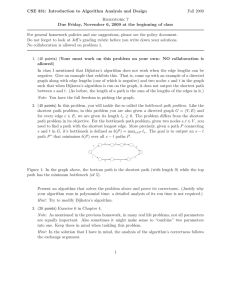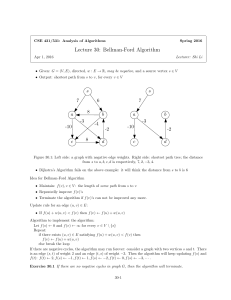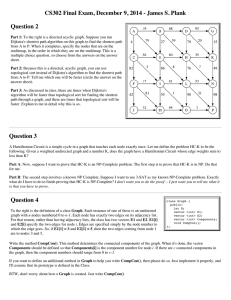
Proceedings of the Twenty-Fifth AAAI Conference on Artificial Intelligence
Optimal Route Planning for Electric Vehicles in Large Networks
Jochen Eisner and Stefan Funke and Sabine Storandt
Universität Stuttgart, Institut für Formale Methoden der Informatik, 70569 Stuttgart, Germany
jochen.eisner, stefan.funke, sabine.storandt@fmi.uni-stuttgart.de
4. bt is maximal over all such possible paths from s to t
Abstract
Note that without conditions 2 and 3 and minimizing
−b(t) we have a regular shortest path problem, which can
be solved in time O(nm) using Bellman-Ford’s algorithm.
Employing Dijkstra’s algorithm might lead to exponential
running time due to the edge costs possibly being negative
(Johnson 1973).
We consider the problem of routing electric vehicles (EV)
in the most energy-efficient way within a road network taking into account both their limited energy supply as well as
their ability to recuperate energy. Employing a classical result by Johnson and an observation about Dijkstra under nonconstant edge costs we obtain O(n log n + m) query time after a O(nm) preprocessing phase for any road network graph
whose edge costs represent energy consumption or recuperation. If the energy recuperation is height induced in a very
natural way, the preprocessing phase can even be omitted.
We then adapt a technique for speeding-up (unconstrained)
shortest path queries to our scenario to achieve a speed-up of
another factor of around 20. Our results drastically improve
upon the recent results in (Artmeier et al. 2010) and allow for
route planning of EVs in an instant even on large networks.
Our Contribution
The main contributions of our paper are as follows:
• battery capacity constraints – both overcharging as well as
running out of energy – can be modelled as cost functions
on the edges obeying the FIFO property; hence a regular
Bellman-Ford algorithm can be applied to solve the problem in O(nm); this simplifies and matches the result in
(Artmeier et al. 2010)
Introduction
• by employing a generalization of Johnson’s potential
shifting technique to the (partly) negative edge cost functions we make Dijkstra applicable; this results in a drastically improved query time of O(n log n + m)
With the increasing popularity of electric vehicles (EV) as an
alternative to fossil fuel driven cars, new routing problems
arise that were not as relevant before. Due to large petrol
tanks and the very dense network of gas stations, availability
of energy is almost no issue for ordinary cars. Current EVs,
though, are still hindered by an energy reservoir that limits
their cruising range. On the other hand, EVs have the ability to recuperate energy during deceleration phases or when
going downhill as long as this does not exceed the capacity
of their energy reservoir. Formalized as a graph problem we
are faced with the following question:
Given a graph G(V, E) with a possibly negative cost function cost : E → R but without any negative cycle, a source
node s ∈ V , some L ∈ R+ (the initial charge level), some
M ∈ R+ , M ≥ L (maximum charge level), and a target node t ∈ V , determine a path p = v0 v1 . . . vk with
s = v0 , t = vk as well as charge levels bvi for each of these
vertices such that
1. bs = L (we have not used any energy at the start)
2. bvi = min(bvi−1 − cost((vi−1 , vi )), M ), i = 1, . . . , k
(taking edge costs into account but no overcharging of the
battery)
3. bvi ≥ 0, i = 1, . . . , k (we must never run out of energy)
• the specific construction of our edge cost functions allows
for the adaptation of a speed-up strategy for shortest path
queries – contraction hierarchies (Geisberger et al. 2008)
– resulting in ultra fast queries without suffering from the
problem of complexity growth of the function descriptions; this improvement is directly reflected in our experimental results on large, real-world problem instances
Modelling Battery Constraints
There are two obstacles that prevent us from using standard Dijkstra (as well as of speed-up techniques like edge
reach, transit nodes, or contraction hierarchies): first, the
edge costs may be negative (which corresponds to energy
recuperation along some road segment) which forbids the
use of Dijkstra and only allows for the application of the
O(nm) Bellman-Ford algorithm; secondly, we have the battery constraints which seem to require special algorithmic
treatment. In fact, (Artmeier et al. 2010) have shown that a
modified version of Bellman-Ford solves the problem. But
like Bellman-Ford they can only guarantee a running time
of O(mn) and require a dedicated proof of correctness for
their algorithm.
c 2011, Association for the Advancement of Artificial
Copyright Intelligence (www.aaai.org). All rights reserved.
1108
on the actual battery charge bv at node v.
ized by
⎧
bv
⎨∞
ce (bv ) = conste
bv
⎩
bv − ue + conste bv
In the following we first observe that one can model the
battery constraints by cost functions on the edges obeying
the FIFO property which immediately implies direct applicability of Bellman-Ford without any further thought; furthermore, a generalization of Johnson’s potential shifting
technique yields a problem instance with non-negative edge
cost functions which ordinary Dijkstra can solve. This will
be a prerequisite for the application of an advanced speed-up
technique towards later in the paper.
This can be real< le
∈ [le , ue ]
> ue
with le , ue , |conste | ∈ [0, M ] being parameters depending
on e. For an uphill edge e with conste ≥ 0 we have le =
conste , ue = M , for an downhill edge e with conste < 0
we have le = 0, ue = M + conste . It is easy to see that
this function class subsumes the two previous definitions of
ce and obeys the FIFO property.
Definition 1 A function f : R → R satisfies the FIFO (firstin-first-out) property, if ∀x ≤ y we have x + f (x) ≤ y +
f (y).
In the context of road networks with time-dependent edge
costs this means that one cannot arrive earlier at the end of a
road segment when starting later, in our context, this means
that one cannot end up with more energy at the end of a road
segment when starting with a lower battery level.
We now turn to the modelling of our constraints as edge
cost functions.
Shifting Edge Cost Functions
At this point we are dealing with a graph G(V, E) and for
each edge e ∈ E we have a cost function ce : R → R
obeying the FIFO property. While some of the ce might
have negative function values, there is no negative cycle,
i.e. for any battery charge level bv on a node v we cannot
take a roundtrip and end up with a higher charge status than
bv , otherwise we would have constructed a perpetual motion
machine of the first kind.
For graphs with constant, possibly negative edge costs,
the shifting idea of (Johnson 1977) is to determine a potential function φ : V → R and replace edge costs conste of an
edge e = (v, w) by conste := conste − φ(w) + φ(v). If the
graph has no negative cycles, a φ exists such that conste ≥ 0
∀e ∈ E. It is not hard to see that the shifting does not affect
the structure of shortest paths, since the potential-induced
cost of a path from s to v does not depend on the path itself.
We can derive such a potential function by computing shortest path distances (using Bellman-Ford) from some arbitrary
node x and setting φ(v) := dx (v), where dx (v) denotes the
shortest path distance from x to v.
Generalizing this shifting technique to our edge cost functions requires the node potentials to become functions, so
φ : V → (R → R). While for constant edge costs standard
Bellman-Ford can be used to determine potentials, we now
have to employ Bellman-Ford to perform a profile search
(Delling and Wagner 2009), which as a result not only yields
for any v ∈ V a distance value to x but a function describing the distance dependent on the initial charge level at x.
This is relatively complicated as well as time- and spaceconsuming. If the edge cost functions satisfy an additional
condition (which is naturally fulfilled in our scenario), we
can get away without this inconvenience:
Consider the graph which on each edge e, instead of the
function ce () has constant cost conste := mind ce (d). Assume that the graph with these edge costs does not contain any negative cycle; we can derive a potential function
φ : V → R in the same manner as before for constant edge
costs. Let us convince ourselves of the use of this potential
function for our graph with edge cost functions. We define
as new edge cost functions ce (d(v)) for every e = (v, w):
Never Running out of Energy
Let us look at the constraint that the EV never runs out of
energy, that is, when being at a node v and considering travelling along edge e = (v, w) and conste exceeds the current
charge level of the EV (i.e. conste > bv ), we are not allowed to take this road segment. Note that this concerns only
edges with conste > 0. Consider the function ce : R → R,
ce (bv ) = ∞ if conste > bv and ce (bv ) = conste otherwise.
ce sets the edge cost to infinity if the energy level does not
suffice to get across edge e and to conste otherwise. Clearly
ce satisfies the FIFO property.
No Overcharging
The constraint that the battery charge never exceeds the
maximum charge level M can similarly be modeled in a
cost function. Note that this only concerns edges e = (u, v)
with conste < 0. When arriving with a battery level bu
and such that bu − conste > M , we want the energy level
at w to be M only. Hence define ce (bu ) = bu − M for
bu − conste > M and ce (bu ) = conste otherwise. Again,
the FIFO property holds.
Having encoded the battery constraints into cost functions
on the edges obeying the FIFO property we can use plain
Bellman-Ford; the only difference is that when a node v is
pulled from the queue, the edge cost functions on its outgoing edges are evaluated at bv . If all functions on the edge
costs were positive, even straightforward Dijkstra could be
applied, see (Dreyfus 1968). Unfortunately, this is not the
case here (yet). The edges that lead to a gain in energy bear
cost functions which are partly negative, which we alleviate
later on.
Unified Cost Function Representation
Dealing with two different edge cost functions (depending
on the edge types) is somewhat inconvenient. Therefore
we unify our cost function representation by defining a new
function ce : [0, M ] → R to describe the cost of an arbitrary
edge e = (v, w) (be it a downhill or uphill edge) dependent
ce (d(v)) := ce (d(v) + φ(v)) + φ(v) − φ(w)
Since we have d(w) ≤ d(v) + conste , obviously φ(v) −
φ(w) ≥ −conste ≥ −ce (χ) for any χ and hence
ce (d(v)) ≥ 0.
1109
f ixede + (η(w) − η(v)) for η(w) − η(v) > 0 and conste =
f ixede + α(η(w) − η(v)) for η(w) − η(v) ≤ 0 with some
0 < α < 1. We drop α in the uphill case as this could easily
be compensated for by scaling up the f ixed part.
Plugging in η for the function φ which we had to painfully
construct previously, we see that the desired ce () can be determined with no effort if the underlying model is known.
So in most practical cases we do not need to compute φ using Bellman-Ford but simply use the underlying elevation
function on the nodes of the network.
It remains to show that this transformation does not
change the structure of shortest paths. For that we inductively proof that the cost under the new edge cost function
ce () equals the cost of the old edge cost function ce () minus
φ(vn ):
Lemma 2 Let p = v0 v1 . . . vk be a path with s = v0 and
initial distance value d(s) = d under the original edge cost
functions ce () and the same path with initial distance value
= d − φ(s) under ce ().
d(s)
k ) = d(vk ) − φ(vk ) ∀k ≥ 0.
Then this yields d(v
Proof. This is certainly true for k = 0. For k > 0
k+1 ) = d(v
k) + k )). Acobserve, that d(v
cek (d(v
cording to our new edge cost definition we get
k )) = ce (d(v
k ) + φ(vk )) + φ(vk ) − φ(vk+1 ).
cek (d(v
k
k ) = d(vk ) − φ(vk ), so all in
By induction hypothesis d(v
all we get d(vk+1 ) = d(vk ) + cek (d(vk )) − φ(vk+1 ) =
d(vk+1 ) − φ(vk+1 ).
Speeding-up Queries with Contraction
Hierarchies
The key idea of contraction hierarchies (CH) (Geisberger et
al. 2008) is the iterative removal/contraction of nodes in
a certain order (in increasing ’importance’) while preserving the shortest path distances between the remaining nodes.
This is achieved by adding a so called shortcut (u, w) between any pair of neighbors u, w of v, if the shortest path
from u to w is uvw. The shortcut is created with cost equal
to the sum of the costs of edges (u, v) and (v, w). Having removed all nodes but one, all constructed shortcuts are
added to the original graph and the nodes are labelled 1 . . . n
according to the contraction order. The modified graph has
the interesting property that for any pair s, t of nodes, there
exists a shortest path from s to t which can be divided into
two parts, one part starting at s and only following edges to
nodes with larger label followed by a part which only follows edges to nodes with smaller label. Bidirectional Dijkstra can make use of this special property and leads to an extremely efficient computation of s-t-queries, see (Geisberger
et al. 2008).
The same approach also works for time-dependent edge
costs, see (Batz et al. 2009), but as the authors point
out, contracting nodes in time-dependent networks typically
leads to cost functions on the shortcut edges with increasing complexity and space consumption due to chaining. In
the following we will exhibit some nice characteristics of
our edge cost function class that allow for the space-efficient
employment of contraction hierarchies in our scenario.
Hence our shifting procedure does not affect the structure
of shortest paths – paths that are shortest under the old edge
cost functions are also shortest under the new ones since the
potential-induced cost of a path does not depend on the path
itself.
Finally observe that in our case, the Graph (V, E) with
edge costs conste has no negative cycle. This is easy to see
since we have conste = conste , that is, we have the original
edge costs. By assumption this graph did not have any negace () are trivially
tive cycles. As ce () ≥ 0 for all e and all the shown to fulfil the FIFO property, we can employ Dijkstra’s
algorithm once we have determined the potential function
φ(). Also we can not only calculate the original distances
but also the actual battery charge status on vn = t from the
modified edge costs as bt = bt + φ(s) − φ(t). So subsequent s − t queries can be answered in time O(n log n + m)
(Fredman and Tarjan 1987).
A Realistic Cost Model
In the application scenario of energy-efficient routing, the
typical case where a road segment e = (v, w) bears negative
cost (meaning a surplus of energy when travelling along this
segment) is that the elevation of the target node w is lower
than the one of the source node v, so we are going ’downhill’. It is natural to model the cost of an edge e = (v, w)
as conste := f ixede + α(η(w) − η(v)), where f ixede denotes a height-independent part (e.g. depending on the horizontal distance only), η(w), η(v) the elevations of w and v
respectively, and α, a weight factor which determines how
important the height-dependent part is. Clearly, with this
simple model our problem gets considerably easier as the
height-dependent part of the cost of a path only depends on
the heights of the first and the last node in a path, all other
height-dependent parts cancel out, unless overcharging takes
place, which can be dealt with quite easily, though.
It gets more interesting (and realistic) when we introduce the natural condition that the energy for going uphill (η(w) − η(v) > 0) is not fully recuperated when going downhill (η(w) − η(v) ≤ 0): So we have conste =
Descriptive Complexity
For general edge cost functions the descriptive complexity
might increase with every contraction. For example consider two polynomials of degree k, chaining them leads to a
polynomial with degree k 2 and so for k ≥ 2 the description
complexity increases dramatically. Similarly, chaining two
step functions with different interval boundaries in the worst
case leads to a combined function with about twice the number of steps.
In the following we show, that the cost function of a path in
our edge cost model has bounded descriptive complexity and
hence repeated node contraction does not lead to unbounded
growth in function complexity.
1110
in the length of the path. In the worst case this might lead
to coefficients which need Ω(n) space or to put up with
rounding errors. Fortunately in our case parameters only
get added or subtracted, as the slope of our linear cost
function in the interval ]u, M ] is always 1, see Table 1.
Therefore, irrespectively how many edge cost functions
are chained, we never require more space than the original
edge costs, even better the parameters also never exceed
the range [−M, M ], as if they do we can simply set them
to the interval boundary without changing the function. So
we are able to chain any number of edges and use the same
datatypes to store the resulting parameters as for the original
edge costs.
Figure 1: Two examples of the used edge cost function.
Creation of Shortcuts
Theorem 3 The descriptive complexity of a cost function cp
of a path p on up- and downhill edges is bounded.
When contracting a node v and considering edges e1 =
(w, v) and e2 = (v, z), a shortcut between neighbors w
and z with the chained cost function of e1 and e2 has to
be added, if there exists some battery level at w where the
cost along e1 and e2 is lower than the cost in the graph with
v removed. Naively this requires computing shortest paths
from w to z at all possible battery charge levels at w and
comparing them with the cost function of the path e1 e2 ; in
fact it is possible to do exactly this using a so-called profile search (Delling and Wagner 2009), which is relatively
time- and space-consuming, though. Instead, we discretize
the range of possible battery charges and compute shortest
paths for these charge levels. For each of these paths (containing at least one node different from w, v, z) we consider
its cost function (ranging over all possible charge levels); if
for any charge level one of these cost functions does not exceed the cost function of e1 e2 the shortcut is not necessary.
This can easily be checked by inspecting the cost functions
at all breakpoints. This does not compromise correctness,
it might lead to the addition of some unnecessary shortcuts,
though. Note that this construction of the contraction hierarchy sometimes leads to multiple edges between a pair of
nodes since our allowed function class does not allow for
construction of shortcuts bearing the minimum of a set of
cost functions. Our experimental evaluation shows, though,
that this only happens rarely and still allows for a drastic
speed-up.
Proof. Consider an arbitrary path p = sv1 v2 · · · vk−1 t
in the graph G(V, E) with edge costs as defined before.
Let l be the minimal battery charge a vehicle has to have
at node s to reach t along p, i.e. none of the edge costs
cei () become ∞ for that starting charge at vi . Because
of the FIFO property we get ∀bs < l : cp (bs ) = ∞.
Amongst all charges at s larger or equal to l let u be the first
charge where overcharging along p kicks in (it is possible
that u = l). Again, due to the FIFO property all initial
charges lower than u do not cause overcharging, hence
k
∀bs ∈ [l, u] : cp (bs ) = i=1 constei . For battery charges
greater than u there is at least one node vi∗ where the battery
is fully loaded. Therefore b = bt is the same ∀bs > u
and so the path costs on this interval can be expressed
by a linear function, more precisely as the difference of
the initial battery power and b. So in summary we need
k
l, u, const =
i=1 constei and bs to describe the cost
function of an arbitrary path in G and hence the descriptive
complexity of chained edge cost functions is bounded.
Calculation of Chained Edge Costs
When creating a shortcut between neighbors v and v of a
node v to be contracted, we need to combine the edge cost
functions of edges e and e that form a shortest path vev e v from v to v via v . The newly created shortcut edge edge ê
gets as cost function cê (bv ) := ce (bv ) + ce (bv ) = ce (bv ) +
ce (bv − ce (bv )). Three cases need to be distinguished as in
Table 1.
From this description it is obvious that the cost function
for the short cut edge can be found in constant time.
Queries
To answer a query from some node s with battery charge
level bs to some node t we run a breadth first search (BFS)
from s identifying all nodes that are reachable from s via
edges from smaller to larger labelled nodes, and a BFS
from t identifying all nodes that can reach t via edges from
larger to smaller labelled nodes (this follows the exposition
in (Delling and Wagner 2009)). On the identified edges we
run Bellman-Ford (as we still have negative edge weights).
But then we can employ the shifting idea from Section to
obtain a graph with non-negative edge costs on which Dijkstra is applicable. So we can take full advantage of fast
Dijkstra as well as the contraction hierarchy.
No Space Overhead In practice it might not be enough
to have a path cost function with bounded descriptive
complexity. Consider for example a cost function linear in
bv with slope larger than one on every edge. When chaining
this type of cost function along some path, the coefficient of
the (still linear) chained cost function grows exponentially
1111
ue < le + conste
ue ∈ [le + conste , ue + conste ]
ue > ue + conste
lê
M
max(le + conste , le )
max(le + conste , le )
uê
M
max(lê , ue )
max(lê , ue + conste )
constê
∞
conste + conste
conste + conste
Table 1: Case distinction for chaining edge cost functions.
Experimental results
functions.
We present the results for two test graphs, which are based
on OpenStreetMap1 data augemented with SRTM height information2 and can be characterized as mountainous. The
smaller one – the German Taunus – contains 11220 nodes
and 24119 edges. Furthermore we had a map of Southern
Germany with 5588146 nodes and 11711088 edges. Our
implementation is written in C++, timings were taken on a
single core of a AMD Phenom 9850 Processor with 2.5 GHz
and 16 GB RAM. Preprocessing to get the contraction hierarchy for the larger graph took about 6 CPU hours and added
≈ 1.6 million edges, resulting in an augmented graph with
roughly 2.5 times the number of original edges.
The initial battery charge was chosen such that the underlying search space was not restricted by insufficient initial
energy. For smaller battery charges, queries are even faster,
of course.
Taunus
Bellman-Ford
Dijkstra
CH
Southern Germany
Bellman-Ford
Dijkstra
CH
polls avg (std)
14080 (10257)
3883 (8084)
69 (127)
polls avg (std)
2.03 · 108 (6.32 · 107 )
5.11 · 106 (3.28 · 106 )
5.53 · 104 (3.86 · 104 )
109
ops
108
6
10
5
BF
Dijkstra
104
10
2
10
1
100
10-1
CHDijkstra
100
101
time in s
102
Figure 2: Runtime in s and cost in (priority)queue polls measure-
below
measurement
precision
avg runtime in s
66.91
3.43
0.18
ments for 1000 random queries on the Southern Germany graph for
our approaches. Both scales are logarithmic. The CH Dijkstra does
always have to mark the up and down edges, resulting in a minimal
static runtime of about 0.1s for running these two BFSs.
In Figure 2 we see that the running times in general are determined by the number of (priority)queue polls, even though
there is a constant cost for CH Dijkstra due to the marking
of the edges using BFS.
As expected for real data the percentage of edges with negative costs is very small even for graphs with large height
differences. Still, taking into account energy consumption
and recuperation due to the height differences results in quite
different paths, see Figure 3. Note that the paths in Figure
3 do not differ much in length but considerably in terms of
energy consumption. Choosing the right path might make
the difference between being able to reach the target or to
run out of energy in the middle of the trip. The EV chooses
a path that avoids driving uphill as far as possible, leading to
a higher final battery charge see Figure 4. Energy can also
get lost when driving downhill, see Figures 6 and 5. If the
initial battery charge is more than 96.5875% we always end
up with a final charge level of 98.5%. That means, starting
with a full battery leads to a positive total energy consumption due to the overloading constraint, while we could gain
energy on the very same path using a smaller initial battery
charge.
In general we observe that routing vehicles under battery
constraints and height-induced edge cost functions leads to
considerably different optimal path structures, still queries
can be answered very efficiently with our approach.
random queries. “polls” is the number of (priority)queue polls,
standard deviation in brackets, runtime given in seconds. Timings
on the Taunus graph were omitted as they were too small to be
measured.
In Table 2 we see that the number of poll operations as
well as the runtime decreases drastically when using Dijkstra instead of Bellman-Ford and another order of magnitude less can be achieved by applying contraction hierarchies. Note, that only the latter allows us to answer queries
in a fraction of a second and hence provide instant answers
in practice.
Compared to (Artmeier et al. 2010) which only consider a
graph of about 1/8th the size, our Dijkstra strategy is superior, whereas our CH strategy beats their results by an order
of magnitude. The former can be explained by our potential
shifting technique which guarantees O(n log n+m) running
time in contrast to worst-case exponential running time of
Dijkstra in (Artmeier et al. 2010). The latter is simply due
to the raw power of contraction hierarchies not being hindered by uncontrolled complexity growth of the edge cost
2
10
103
Table 2: Runtime comparison: Values are averaged over 1000
1
10
7
www.openstreetmap.org/
www2.jpl.nasa.gov/srtm/
1112
900
100
elevation in m
700
90
80
70
600
60
500
50
400
40
30
300
battery load in %
dHeight
dBattery
jHeight
jBattery
800
20
200
10
100
0
10
20
30
40
50
60
70
80
0
90 100
relative position on path in %
Figure 3: This is a map section of the german Taunus, spanning an area of about
16.1 × 6.8km. The background colors are indicating the elevation ranging from 99m as
deep blue to 412m as red. Two map spanning paths are shown, sharing the same source in
the northeastern corner directing westward and also ending in the same target. The upper
violet path is the one generated by Dijkstra and is a shortest path in respect to eucledean
length. The lower red one is the energy optimal path generated by Johnson.
Figure 4: dHeight and jHeight are the elevation profiles for the Dijkstra and Johnson paths
shown in fig. 3. dBattery and jBattery are
the corresponding battery charges. Although
the eucledean length of the Dijkstra path is the
shorter one, the energy consumption is higher,
resulting in a lower final battery charge.
300
100
280
98
Height
90
96.5875
98
240
220
96
94
200
180
battery load in %
elevation in m
260
92
160
90
140
0
10
20
30
40
50
60
70
80
90 100
relative position on path in %
Figure 5: This is the same map section as shown in fig. 3. The violet path on the right
starts at 279m and ends at 149m if followed in eastern direction. The downhill nature of the
path allows us to study the influence of initial battery charge on battery overloading and net
energy cost.
References
Figure 6: Height is the elevation profile of
the path, shown in fig. 5, starting at 279m and
ending at 149m. 90, 96.5875 and 98 are the
battery charge on each path node where the
respective number is the initial battery charge
(ie. 90%). 96.5875% marks the highest possible battery charge where no overloading occurs.
Fredman, M. L., and Tarjan, R. E. 1987. Fibonacci heaps
and their uses in improved network optimization algorithms.
J. ACM 34:596–615.
Geisberger, R.; Sanders, P.; Schultes, D.; and Delling, D.
2008. Contraction hierarchies: faster and simpler hierarchical routing in road networks. In Proceedings of the 7th international conference on Experimental algorithms, WEA’08,
319–333. Berlin, Heidelberg: Springer-Verlag.
Johnson, D. B. 1973. A note on dijkstra’s shortest path
algorithm. J. ACM 20:385–388.
Johnson, D. B. 1977. Efficient algorithms for shortest paths
in sparse networks. J. ACM 24:1–13.
Artmeier, A.; Haselmayr, J.; Leucker, M.; and Sachenbacher, M. 2010. The shortest path problem revisited: Optimal routing for electric vehicles. In 33rd Annual German
Conference on Artificial Intelligence (KI-2010).
Batz, G. V.; Delling, D.; Sanders, P.; and Vetter, C. 2009.
Time-dependent contraction hierarchies. In Finocchi, I., and
Hershberger, J., eds., ALENEX, 97–105. SIAM.
Delling, D., and Wagner, D. 2009. Time-dependent route
planning. In Ahuja, R.; Mhring, R.; and Zaroliagis, C., eds.,
Robust and Online Large-Scale Optimization, volume 5868
of Lecture Notes in Computer Science, 207–230. Springer
Berlin / Heidelberg.
Dreyfus, S. E. 1968. An appraisal of some shortest path
algorithms. In ORSA/TIMS Joint National Mtg., volume 16,
166.
1113





